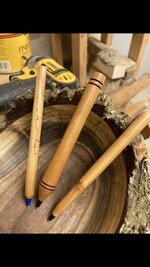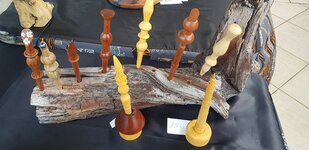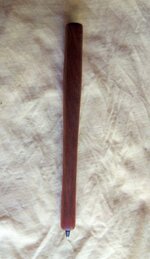Not sure what the sized of the through hole on the Jet headstock spindle is. But I am guessing almost 3/4"
If you pick up a Collet Chuck, you can do what I do. If you turn the blank round first, you can push it through the collet chuck, all the way through the head stock. This will leave lots of room for drilling, and it keeps the end of the blank close to the chuck for lots of support.
This will also work with a normal chuck, if it has a large enough hole through the center.
I was initially confused by this post, but I think what Darrin is saying is that he turns the blank round, and then mounts it in a collet chuck with most of the blank inside the headstock spindle. As a result, the length of the blank doesn't subtract from the working length of the lathe bedways.
Unfortunately, I'm not sure this is a good ideal. For this to work, the blank has to be turned to a diameter that is less than the bore of the headstock, and that could be an obstacle with many lathes. Remember that there is a morse taper at the end of the bore, and the internal diameter of a standared MT2 taper at its small end is 0.572", so that is the maximum diameter of a blank that will fit inside the bore. So the maximum diameter that the blank could have is only slightly more than 1/2" - and that's risky because a thin blank is far more likely to crack due to heating from swarf buildup in the drill bit flutes.
The other concern here is that my experience is that drilling the very small hole required for Bic sticks is tricky. Small diameter drill bits can flex, and its not uncommon for the bit to wander off axis and out of the side of the blank. That's not a good thing, but at least if the full length of the blank is visible, you can tell when it happens and stop drilling. But there would be no way to know if that happens if the blank is contained within the headstock bore, possibly causing damage to the headstock.
Sadly, Brendan Stemp appears to have taken down all of his YouTube videos including the one on Bic pens. I did find t
his video by Phil Cooke in which he demonstrates drilling using a hand-held drill bit. He uses a 1/8" inch bit for the body cavity rather than the 9/64" bit that I use -1/8" is large enough to contain the Bic refill, and many hardware stores will have 1/8" x 6" bits in stock, while a 9/64" bit will usually have to be ordered from a specialty supplier (or Amazon). But as I said in the previous post, I suggest drilling the entire hole at either 1/8" or 9/64", turning the pen body, and then redrilling the first 1/2" or so of the hole with a 5/32" bit after the pen has been completed. But all of this constitute variations on the theme of how the cat can be skinned. Phil didn't mention the hole depth - the Bic refill is 4 7/8' long, so I make the hole 5" deep.
Two additional points - first, I prefer to keep the design of the pen simple - I like to taper the body from the nib to the end of the pen, with a slightly narrowed section (basically, a very long,
very shallow cove) about 1 1/2" back from the nib - I think this makes the pen more comfortable to hold. The optimum diameter of the body is somewhere between 3/8" and 1/2" - any thinner and the pen becomes too fragile and hard to hold, and any thicker and it's too bulky. And I make the overall length between 5 1/4" and 5 1/2", and apply minor creative treatments only at the end - grooves, domes, flats, etc. And if possible, I hide the 'breather hole' I discussed earlier in a groove so that it is almost completely invisible.
Second, and this is a real nuance - my experience is that if the nib-end of the pen is too thin, the stress of inserting the refill into the 5/32" hole can cause the wood to split - and the risk tends to vary depending on the timber being used. So I try to make the taper very shallow, and round the shoulder at the nib so that the wood is just a bit thicker at that point of stress.




